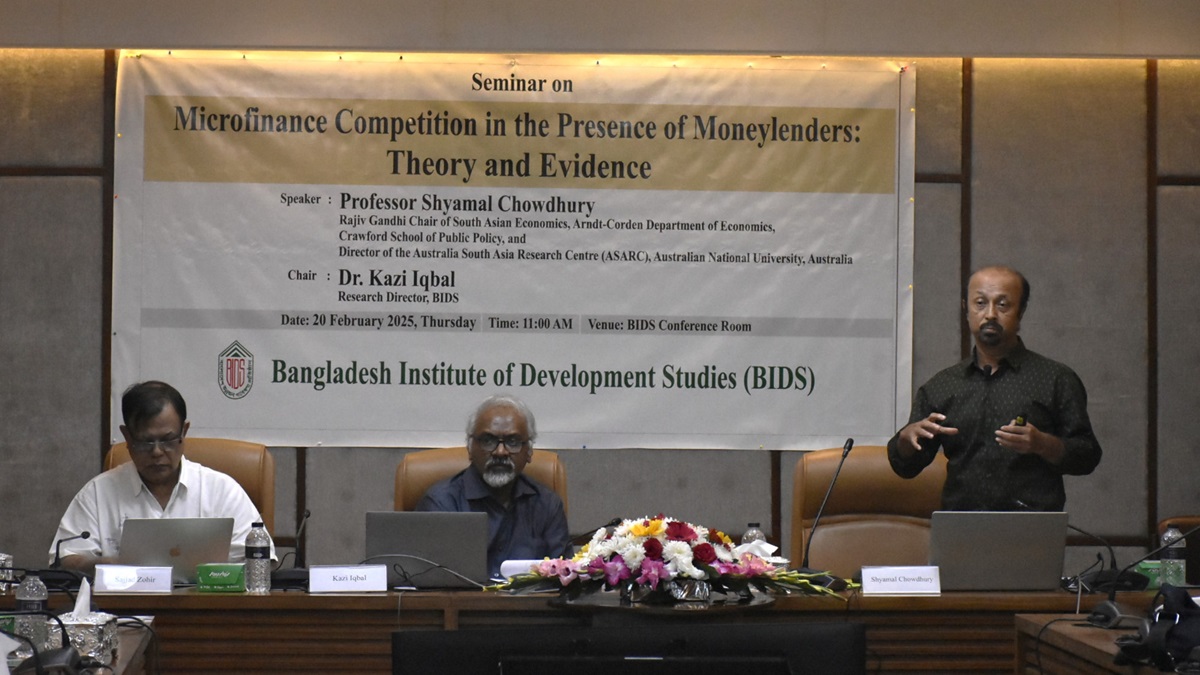‘Microfinance Competition in the Presence of Moneylenders’
BY Insider Desk
February 23, 2025

Bangladesh Institute of Developmental Studies (BIDS) held a seminar on Shyamal Choudhury, Prabal Roy Choudhury, and Joeri Smits’ paper, ‘Microfinance Competition in the Presence of Moneylenders’.
Professor Shyamal Choudhury, Rajiv Gandhi Chair of South Asian Economics, Arndt-Corden Department of Economics, Crawford School of Public Policy, and Director of the Australia South Asia Research Research Centre (ASARC), Australian National University, presented the paper in the seminar.
Dr. Sajjad Zohir, Executive Director, Economic Research Group (ERG) and Md. Fazlul Kader, Managing Director, Palli Karma-Sahayak Foundation (PKSF) were the Distinguished Discussants of the seminar.
Shyamal Chowdhury started the presentation by saying, “The entire paper is based on theory.”
He then briefly explained how microfinance works and benefits villagers. It loans them money with a lower interest rate than money lenders, more commonly known as ‘Mohajon’ in rural areas.
Dr. Muhammad Yunus, often considered the father of microfinance, established Grameen Bank in 1983. At that time, it was the only microfinance institution (MFI) in Bangladesh.
However, the number of MFIs has significantly increased in the next two to three decades. This is where the ‘Microfinance Competition’ emerges, and so does the paper by Shyamal Chowdhury.
Shyamal Choudhury stated, “The paper works with the idea that MFIs are benevolent and not about profit.” The paper also presumes the borrowers have an asset value of absolute zero.
The paper found that with MFIs’ overt competition, borrowers take loans from money lenders only when there is a production shock, which refers to a sudden and unexpected disruption in the production process, causing a significant change in the quantity supplied.
“This model used gradual increases in MFI competition rather than either perfect competition or monopoly MFI, with complementarity between MFI and money-lender credit,” said Shyamal Choudhury.
The eventual result of MFI competition becomes “no increase in number of loans from MFIs but decrease in number of loans from money-lenders,” as the research finds, but it also finds “no increase/decrease in the overall number of loans.”
The paper also suggests that the money-lender interest rate went down on average for villages; however, money-lender interest is more ‘individualistic’ as it depends on the amount and payment timing.
After Shyamal Choudhury’s presentation, researchers, professors, and economists shared their thoughts and feedback on the paper.
The paper’s conclusion suggests that borrower welfare has decreased. Several present researchers asked, “As there is no decrease in the overall number of loans, why is there any decrease in welfare?”
Shyamal Choudhury pointed out that it is a theory, and the entire paper is theoretical, so it hasn’t been answered here.
To answer “if there was any selection process for money lenders,” Mr. Chowdhury replied, “We asked the borrowers and followed a comprehensive process.”
Overall, the paper received appreciation at the conference, along with some concerns raised by professionals.
Tags:
Most Read
You May Also Like